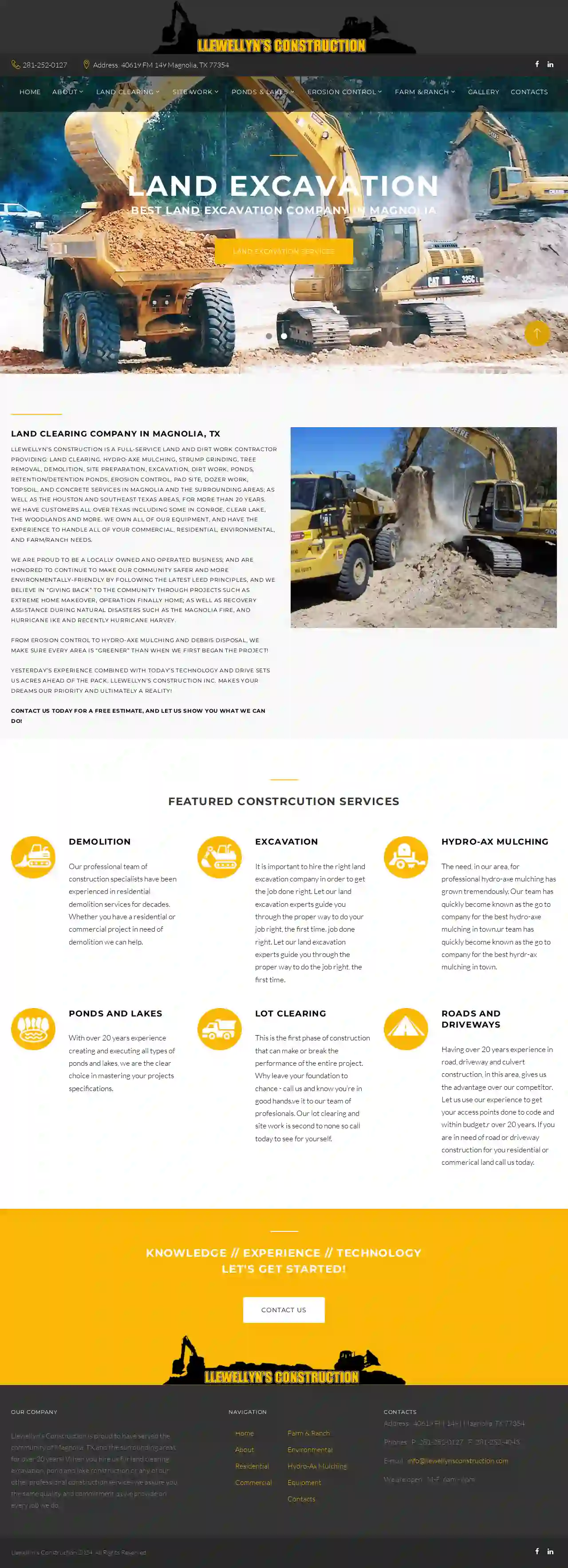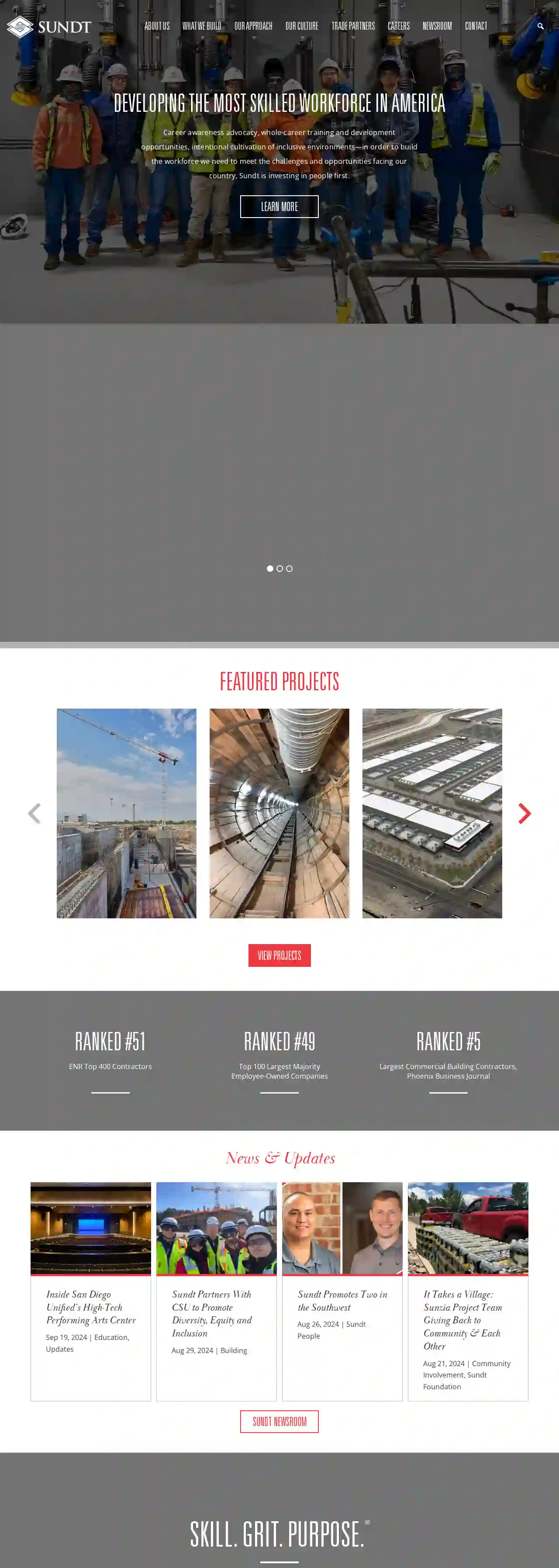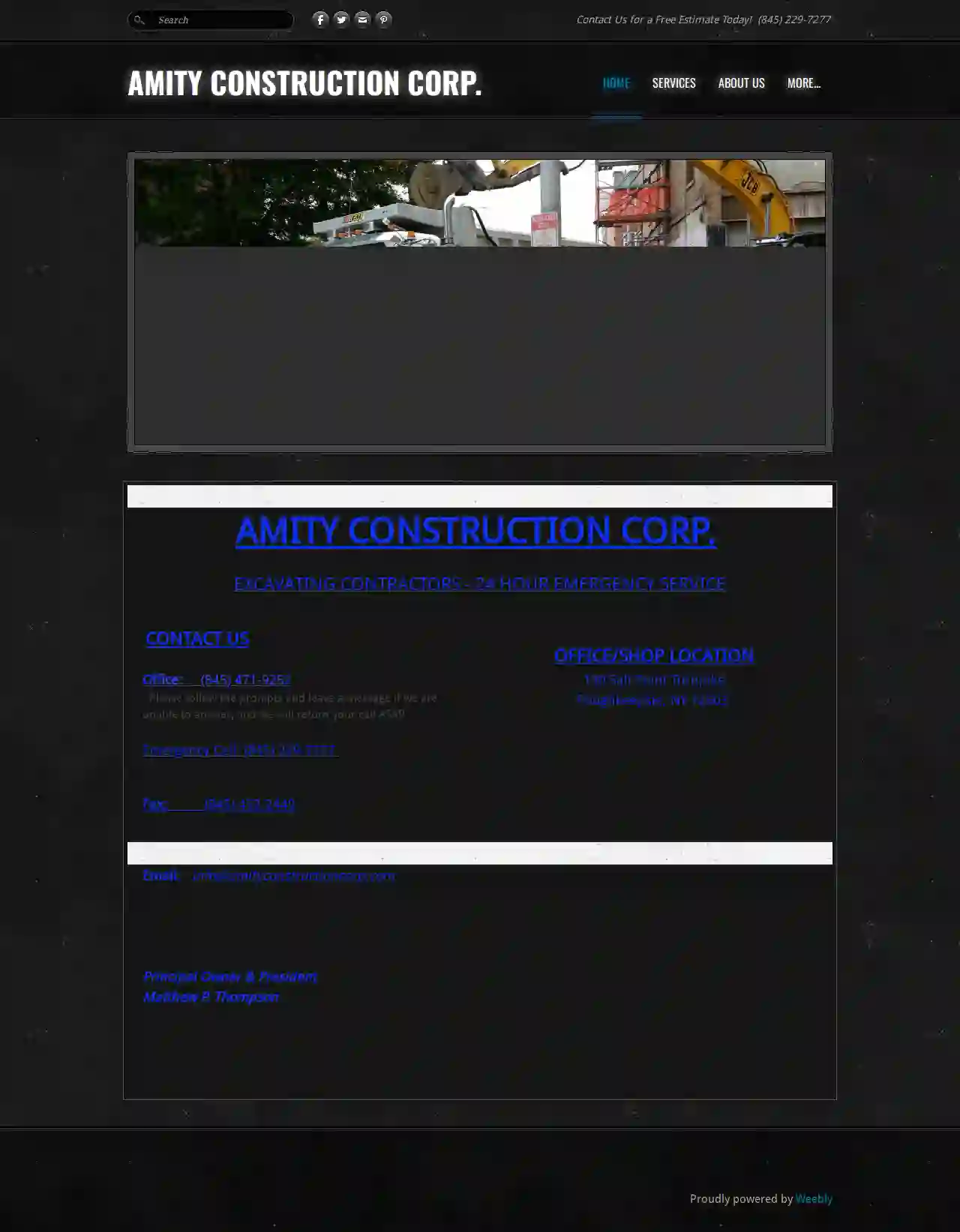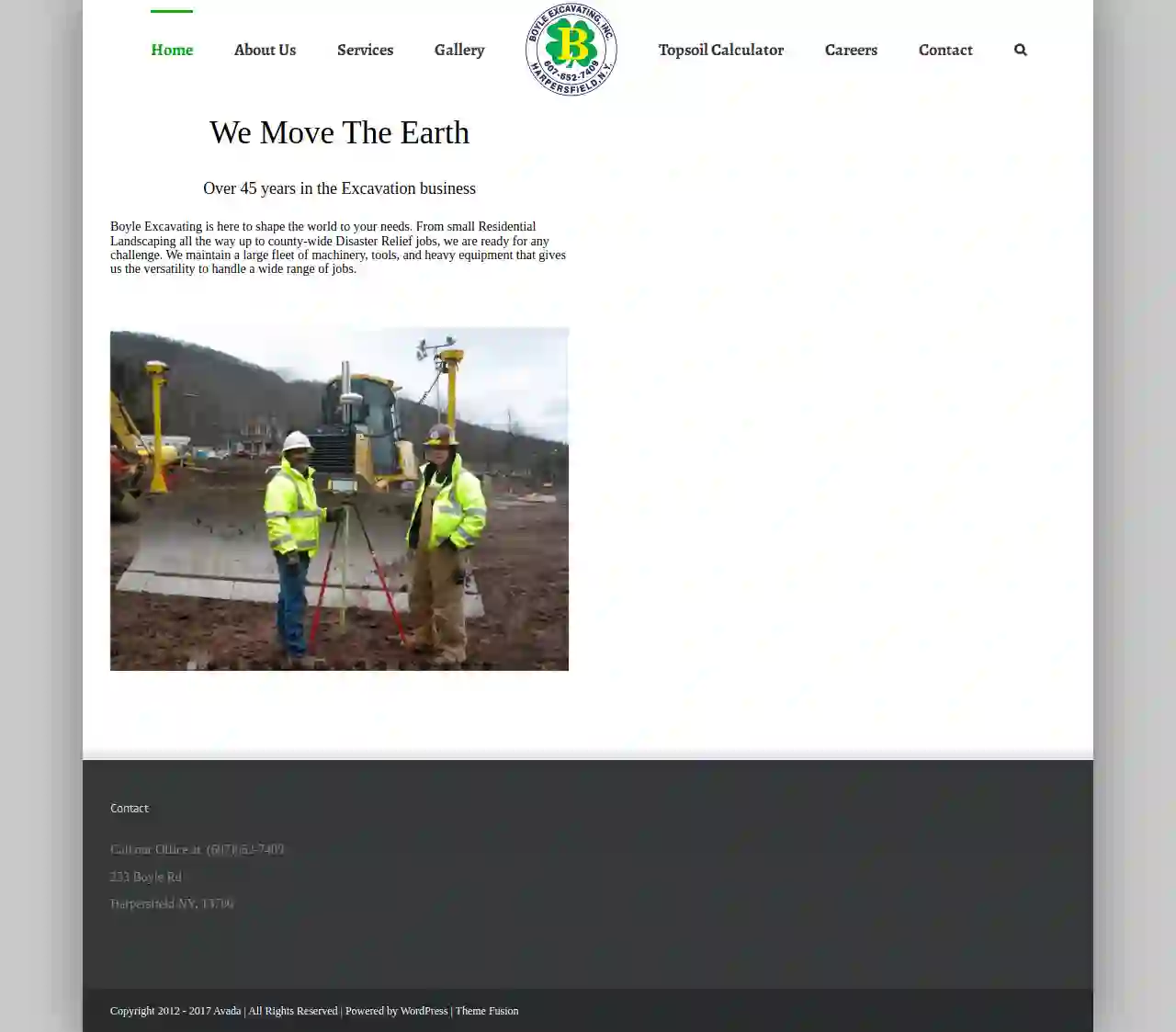Excavation Contractors Sugar Land
Find Excavation Contractors in Sugar Land
Receive up to 3 Excavation Contractor quotes for your project today! Compare profiles, reviews, accreditations, portfolio, etc... and choose the best deal.
- DM
DMD Excavating
51 reviewsSpring, US- Services
- Why Us?
- Gallery
Get Quote 
Llewellyn's Construction
4.25 reviews40619 FM 149, Magnolia, 77354, USLlewellyn's Construction: Your Trusted Partner for Land Clearing, Excavation, and More Founded in 1996 by John Llewellyn, Llewellyn's Construction has grown from a small "dozer" company to a trusted leader in all phases of earthwork for Montgomery, Harris, Walker, Waller, Grimes, and surrounding counties. We've built a reputation for quality, commitment, and exceeding customer expectations. We're proud to be a locally owned and operated business, committed to making our community safer and more environmentally friendly by following LEED principles. We also believe in giving back through projects like Extreme Home Makeover, Operation Finally Home, and disaster relief efforts. Our team of experts has the experience and technology to handle all your commercial, residential, environmental, and farm/ranch needs. We own all our equipment, ensuring we can deliver efficient and effective solutions for every project. From erosion control to hydro-axe mulching and debris disposal, we make sure every area is "greener" than when we first began the project! Llewellyn's Construction makes YOUR dreams our priority and ultimately a reality! Contact us today for a free estimate and let us show you what we can do!
- Services
- Why Us?
- Gallery
Get Quote
Sundt Construction
49 reviewsSan Antonio, USAbout Sundt Sundt is committed to being the most skilled builder in America, owned and led by the industry’s top construction professionals. Our diverse expertise serves clients across the United States. History Founded in 1890, Sundt has a storied history of landmark projects across the country. Our Team As a 100% employee-owned company, we are committed to collaboration and accountability: shared responsibility and shared success. Sundt Foundation The Sundt Foundation reflects our employee-owners’ passion for giving back to the communities where we live and work. Our Regions As one of America’s largest and most respected general contractors, we have a portfolio of projects and roots spanning coast to coast. Awards & Recognition Our accomplishments reflect our employee-owners’ efforts and the spirit of cooperation and partnership we share with our clients.
- Services
- Why Us?
- Gallery
Get Quote
Amity Construction
48 reviews130 Salt Point Turnpike, Poughkeepsie, 12603, USAbout Amity Construction Corp. Amity Construction Corp. has been serving the Hudson Valley since 2005. Our office is located in Poughkeepsie, NY, and we serve both residential and commercial customers in the surrounding area. Amity Construction Corp is a community-oriented, Equal Opportunity Employer. Our Experience We have a proven track record of success, having completed numerous projects for a wide range of clients, including: Village of New Paltz (2023): Consent Order Compliance, Sewer Upgrades, Sewer Remediations Packenkill Union Free School District (2023): Site Construction for Hagan & Nassau Elementary Schools, Site Construction for Orville Todd MS Town of Wawarsing (2022-2023): Local Roads, Residential Water Services NYS OGS (2022-2023): Storm Drain Improvements, Rockland PC Hudson River Campus, Poughkeepsie, NY Wappingers Central School District (2022): Site Wide Renovations Dutchess BOCES (2021-2023): Site Work Salt Point, Additions and Alterations Village of Ellenville (December 2020): Water Main, Village Hydrant & Valve Replacement Town of Carmel (November 2020): Water & Irrigation System Village of New Paltz (September 2020): Sewer Remediation National Park Service - FDR - Red House Water Line (November 2019) HVRA - DCC Airport Building - Water Line Construction Eastdale Village - NYSDOT Site Work (November 2019) HVRA - ARFF/ SRE Building - Water Line Construction HVRA - AAG Water Connection (August 2019) Dutchess County Jail (Temporary Service for JTC project) NYS OPRHP – Taconic Region – Bash Bish Cabins (Waste Water System Replacement) North Salem Central School District - PQ Septic (August 2018) Wappingers Central School District - John Jay HS (July 2018): Sewage & Water Main Upgrades Hudson Valley Federal Credit Union - Route 9, South Road, Poughkeepsie, NY (January 2018): Site work for New Branch South Drive Bridge Repairs, Hyde Park, NY (August 2017) Hudson Valley Federal Credit Union - Route 9, Hyde Park, NY (September 2017): Site work for Drive-Thru Renovations Hudson Valley Federal Credit Union - Route 55, Lagrange, NY (November 2016): Site-work for New Branch Hudson Valley Federal Credit Union - Route 9, Fishkill (October 2015): Site-work for New Branch Victory Lake Nursing Home (Hyde Park, NY) The Townhomes at Inwood Lake (Poughkeepsie, NY) Roosevelt Fire District (Hyde Park, NY) Frantoni Villas (Hyde Park, NY) Hyde Park Nursery School (Hyde Park, NY)
- Services
- Why Us?
- Our Team
- Gallery
Get Quote
Horkus Commercial Construction Company
125329 Budde Rd, The Woodlands, 77386, USBuilding dreams, one brick at a time. Horkus Construction is a reputable construction company based in Houston, Texas. With a strong portfolio and a dedicated team, we strive to deliver exceptional results for our clients. Our Company History Horkus Construction has been taking a leading role in providing construction services with an uncompromised commitment to Quality, Health, Safety, and Environment. We do this through the combination of an open relationship with our employees based on mutual trust, transparency, accountability, and discipline. OUR MISSION At Horkus Construction, our mission is to provide top quality craftsmanship at an affordable price. We believe that it is of high importance to build relationships rooted in trust. We work together to push through barriers and excel in making your next project your dream come true. OUR VISION To develop relationships and gain the trust of our customers. We strive to be the first company that comes to mind when you think of dependability and excellence. Horkus Construction aspires to be the top construction company in Houston and the surrounding areas. OUR VALUES Who we are and what we stand for: Honesty: We believe that honesty is the best policy. You can rely on Horkus Construction to provide exceptional workmanship tailored to your unique needs. Originality: Horkus Construction strives to think outside the box to help you design your next project. Results-Oriented: The Horkus Construction team is results-oriented. We work day in and day out to build your dream. Knowledge: We pride ourselves in constantly growing our knowledge in the ever-changing industry. Unity: The Horkus team is tightly knit and works hand in hand to excel at providing impeccable service. Simplicity: We work by your side to make the experience with the Horkus Construction team enjoyable and hassle free.
- Services
- Why Us?
- Our Team
- Gallery
Get Quote
Lucketts Excavating Inc
52 reviewsSpring, USWe raise the bucket and the bar. Your all-purpose excavating contractor servicing the greater Loudoun County, Virginia area. Professional, local & reliable excavation service provider. We cover it all—from new construction to repairs—as your Loudoun County, Virginia local all-purpose excavating contractor. We upgrade your property to improve both its look and functionality with our top of the line services and solutions. Our Checklist Guarantee. LICENSED & INSURED CERTIFIED RESPONSIBLE LAND DISTURBER QUALITY WORK HONEST PRICING We're your go-to local & trusted excavator. Award winning excavation services. We are proud to serve the greater Loudoun County, Virginia area and we thank our wonderful clients for voting us the top excavation company for the past seven years in a row! This past year we received the LoudounNow's Loudoun's Favorite Award for General Excavation Company—we look forward to continuing to serve our Loudoun neighbors and residents. Distinguished local clientele. We service both residential and commercial properties, and over the years we've had the pleasure of serving some of NoVa's most recognizable staples.
- Services
- Why Us?
- Gallery
Get Quote
Boyle Excavating Inc
4.912 reviews233 Boyle Road, Harpersfield, 13786, USBoyle Excavating: Over 45 Years of Experience Boyle Excavating has been shaping the world to meet your needs for over 45 years. From small residential landscaping projects to large-scale county-wide disaster relief efforts, we're ready to tackle any challenge. Our extensive fleet of machinery, tools, and heavy equipment provides the versatility to handle a wide range of jobs. Our commitment to using the latest technology ensures our customers receive the best possible results. We believe in staying ahead of the curve, as technology is constantly evolving. We're passionate about our work and excited to see what each new day brings. We take pride in transforming dreams into reality, working closely with construction managers who recognize our dedication and ability to handle any task. Our team of dedicated and loyal employees is the backbone of our success, allowing us to deliver exceptional quality in every project.
- Services
- Why Us?
- Our Team
- Gallery
Get Quote
Sky High Contracting
55 reviewsFort Worth, USAbout Sky High Contracting At Sky High, we are more than just contractors – we are a family-owned business deeply rooted in the heart of Fort Worth, Texas. With strong family values at our core, our journey began right here in this vibrant community. What started as a small endeavor has grown into a trusted name in excavation, forestry mulching, landscaping, and concrete work. Our commitment to Texas is more than just business; it's a shared commitment to enhancing and preserving the natural beauty of our surroundings. As stewards of the land, we blend innovation and tradition to create sustainable and breathtaking outdoor spaces. From meticulously sculpted concrete foundations that stand as a testament to our craftsmanship, to the artistry of transforming overgrown areas into thriving ecosystems through forestry mulching – each project reflects our passion and dedication. With a hands-on approach and a deep understanding of local terrain, we collaborate closely with our clients to bring their visions to life. Our work is a reflection of our love for this community, and we take pride in every corner of Texas that we've had the privilege to shape. Join us at Sky High and let's continue building a legacy that harmonizes nature, family values, and unparalleled expertise.
- Services
- Why Us?
- Testimonials
- Gallery
Get Quote
Straight Line Foundation Repair & Drainage, LLC
4.627 reviews8112 White Settlement Rd., Fort Worth, 76108, USStraight Line Foundation Repair: Your Trusted Partner for Lasting Solutions Straight Line Foundation Repair & Drainage in Dallas, Fort Worth & Abilene is dedicated to providing every client with a long-lasting solution for their foundation problems. We take pride in our work and guarantee that our foundation repairs will stand the test of time. If you're in the Fort Worth, Dallas, or Abilene, Texas area and need a reliable foundation repair specialist, look no further than Straight Line Foundation Repair & Drainage. We understand that a strong foundation is crucial for a strong home. That's why our team of experienced professionals has spent years restoring and repairing foundations throughout North Texas. We also specialize in commercial foundation repair, ensuring that your business has a solid base to thrive on. At Straight Line Foundation Repair & Drainage, we are fully licensed and insured, and we work closely with our clients from the initial assessment to the final repair. We provide a straightforward evaluation of your foundation and offer a detailed estimate for any necessary repairs. Our commitment to exceptional customer service sets us apart. We believe in transparency and honesty. We'll explain the cause of your foundation problems and provide you with the best possible solution. We're confident that you'll be satisfied with our work and our dedication to your peace of mind.
- Services
- Why Us?
- Testimonials
- Gallery
Get Quote
Rayco Excavation & Construction
52 reviewsCaddo Mills, USAbout Rayco Excavation & Construction Rayco Excavation & Construction is a professional & experienced land clearing & construction company that is located in Caddo Mills, TX. We provide our clients with a wide range of services including, but not limited to: excavation, land clearing, general construction, grading, site prep & more. Our company works with commercial, residential, & government clients, providing quality services and premier customer service on every project. To learn more about what Rayco Excavation & Construction has to offer, please select from one of the following options: (214) 708-1206 Request a Free Quote
- Services
- Why Us?
- Gallery
Get Quote
Over 3,943+ Excavation Businesses on our platform
Our excavation contractors operate in Sugar Land & surroundings!
ExcavationHQ has curated and vetted the Best Excavation Companies arround Sugar Land. Find a trustworthy contractor today.
Frequently Asked Questions About Excavation Contractors
- Determine the Area: Measure the length and width of the area you want to fill. Multiply them to get the area in square feet (or meters).
- Determine the Depth: Measure the difference between the existing grade and the desired grade (how much you need to raise the ground). This is the depth of fill required.
- Calculate Volume: Multiply the area (step 1) by the depth (step 2) to get the volume in cubic feet (or meters).
- Account for Compaction: Fill dirt compacts when it settles, so add 10% to 25% to the calculated volume to account for compaction. The exact percentage depends on the type of fill material.
- Spring and Fall: Often considered favorable due to moderate temperatures and drier soil conditions.
- Summer: Can be suitable, but hot weather can make working conditions challenging and might require additional measures (shade, hydration) for workers.
- Winter: Excavation in winter can be more difficult due to frozen ground, snow, and potential delays caused by inclement weather. It might also require specialized equipment or techniques.
- Excavators: Versatile machines with a bucket, arm, and rotating cab for digging, lifting, and moving earth.
- Backhoes: Similar to excavators but with a digging bucket on the back and a loader bucket on the front, ideal for trenching and smaller excavations.
- Bulldozers: Powerful machines with a large blade for pushing earth, clearing land, and leveling surfaces.
- Skid Steers: Compact and maneuverable loaders with various attachments (buckets, forks) for digging, loading, and grading in tight spaces.
- Trenchers: Specialized machines for digging narrow trenches for utilities.
- Dump Trucks: Vehicles for hauling excavated material to disposal sites.
How do I calculate how much dirt I need for fill?
What is the best time of year for excavation?
What equipment is used for excavation?
What is the difference between excavation and grading?
Excavation: Primarily involves removing earth or other materials from a site. It's about digging down and creating space.
Grading: Focuses on shaping and leveling the ground to a specific slope or elevation. It's about adjusting the existing terrain.
For example, you might excavate a foundation and then grade the surrounding area to ensure proper drainage and a level surface for landscaping.
How do I calculate how much dirt I need for fill?
- Determine the Area: Measure the length and width of the area you want to fill. Multiply them to get the area in square feet (or meters).
- Determine the Depth: Measure the difference between the existing grade and the desired grade (how much you need to raise the ground). This is the depth of fill required.
- Calculate Volume: Multiply the area (step 1) by the depth (step 2) to get the volume in cubic feet (or meters).
- Account for Compaction: Fill dirt compacts when it settles, so add 10% to 25% to the calculated volume to account for compaction. The exact percentage depends on the type of fill material.
What is the best time of year for excavation?
- Spring and Fall: Often considered favorable due to moderate temperatures and drier soil conditions.
- Summer: Can be suitable, but hot weather can make working conditions challenging and might require additional measures (shade, hydration) for workers.
- Winter: Excavation in winter can be more difficult due to frozen ground, snow, and potential delays caused by inclement weather. It might also require specialized equipment or techniques.
What equipment is used for excavation?
- Excavators: Versatile machines with a bucket, arm, and rotating cab for digging, lifting, and moving earth.
- Backhoes: Similar to excavators but with a digging bucket on the back and a loader bucket on the front, ideal for trenching and smaller excavations.
- Bulldozers: Powerful machines with a large blade for pushing earth, clearing land, and leveling surfaces.
- Skid Steers: Compact and maneuverable loaders with various attachments (buckets, forks) for digging, loading, and grading in tight spaces.
- Trenchers: Specialized machines for digging narrow trenches for utilities.
- Dump Trucks: Vehicles for hauling excavated material to disposal sites.
What is the difference between excavation and grading?
Excavation: Primarily involves removing earth or other materials from a site. It's about digging down and creating space.
Grading: Focuses on shaping and leveling the ground to a specific slope or elevation. It's about adjusting the existing terrain.
For example, you might excavate a foundation and then grade the surrounding area to ensure proper drainage and a level surface for landscaping.